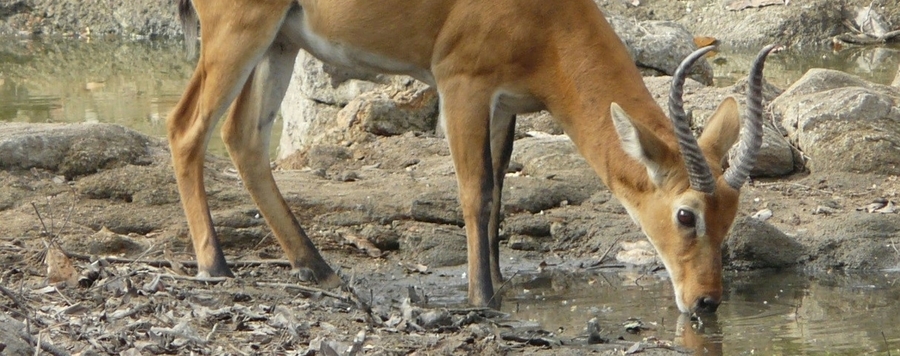The Buffon’s kob antelope is the most common antelope in Central and West Africa. It is the most abundant mammalian herbivore in the network of protected areas of northern Cameroon. Léa Kondasso Taïga from the Department of Biological Sciences, University of Maroua, Cameroon, mentions that a good understanding of the statuses and population dynamics of keystone species such as the Buffon’s kob in this ecosystem can contribute to the successful implementation of the savannah ecosystem conservation programme. “This is why we sought to set up a team of people involved in the research and conservation of antelopes”, Léa Kondasso Taïga continues. The team consists of scientists from the University of Maroua and the School for the Training of Wildlife Specialists Garoua, both in Cameroon, and the Zoological Research Museum Koenig in Bonn, Germany. “I am very pleased to contribute to the project by bringing in my knowledge on antelopes and savannah ecosystems and my experiences gained during my own researches of the puku antelopes (Kobus vardonii) in Zambia,” tells Dr. Vera Rduch from the Zoological Research Museum Alexander Koenig in Bonn. “The puku is not only very closely related to the kob, but they also have a similar lifestyle. Now, the Kob in Cameroon is subject to detailed studies.”
Field work took place at the beginning of the rainy season in June 2018. The national park was subdivided into 146 quadrats that were sampled by teams of helpers. Distance sampling methods were used to collect data on the abundance and distribution of the antelope and, additionally, data on human signs in the national park were recorded.
The results are remarkable: the population of Buffon’s kob was estimated to be 4,094 individuals which was a decrease of 80% compared to data from the year 2000. In contrast to the previous study, kobs were mostly concentrated in the northern part close to the Faro and Déo Rivers and their tributaries. This can be attributed to their biology as kobs are known to graze in areas close to permanent water sources. A weak negative correlation was found between the abundance of kob and human activities. Distributed in the northern areas the kobs avoid the southern areas, where most of the signs of human activities were recorded. And this is, beside other factors such as climate change, where the decline is attributed to. These human activities within the park were mostly related to transhumance and pastoralism as well as poaching activities. Furthermore, wood cutting, honey extraction, agriculture activity and gold panning were observed. Thus, humans have a severe impact on the kob population, directly through poaching and also indirectly due to the possible spread of contagious and deadly zoonotic diseases transmitted by cattle and by habitat conversion. Still, a viable kob population is remaining in Faro National Park. Future conservation efforts should include actions geared towards habitat conservation and anti-poaching. To be effective over the long term, strategies must address both human and wildlife needs.
This cooperation between the researchers from Cameroon and Germany will be continued in the future. Léa Kondasso Taïga tells: “For my PhD project, I will investigate the ecology and status of Buffon’s kob in another of the national parks of Cameroun, in the Bouba Ndjidda National Park, North Cameroon. Beside data on distribution, habitat use and abundance, the study aims at getting insights into the diet of the kob and other bovid species throughout different seasons as well as on the human influence on this ecosystem.” These are basic information of this antelope species, that help in the conservation of this species and the entire Bouba Ndjidda National Park that is presently experiencing a lot of habitat conversion to make way for farm lands. And the information gained shall help to set up a sustainable management plan that contributes to the protection of the once abundant kob antelopes as well as to the conservation of the entire ecosystem.
The article entitled “The status and population dynamic of Buffon’s kob (Kobus kob kob, Erxleben 1777) in the Faro National Park, Northern Cameroon” was published in the African Journal of Ecology: https://doi.org/10.1111/aje.12808
The picture shows a male Buffon’s kob (Kobus kob kob) from the Faro National Park, Cameroon (picture by Léa Kondasso Taïga)
Contact: Léa Kondasso Taïga: Department of Biological Sciences, University of Maroua, Cameroon kondassotaiga [at] gmail.com; Dr. Vera Rduch: Zoological Research Museum Alexander Koenig – Leibniz Institute for Animal Biodiversity, Bonn, Germany, v.rduch [at] leibniz-zfmk.de
Zoological Research Museum Alexander Koenig – Leibniz-Institute for Animal Biodiversity (ZFMK) is an independent research institute. The focus of research is on performing an inventory of the zoological species diversity on earth, on the analysis of changes in biodiversity as a result of environmental factors, and on evolutionary processes at the morphological and molecular levels. ZFMK furthermore explores the context of structure and function of ecological systems, advanced scientific methods, and the study of the history of science. The permanent exhibition “Our blue planet – the living network” offers a genuine nature experience based on naturalistic ecosystem displays.
The Leibniz Association combines 96 independent research institutes. Their focus ranges from the natural, engineering, and environmental sciences to the humanities and the business, space, and social sciences. The Leibniz institutes focus on relevant social, economic, and ecological issues. They perform knowledge-oriented and applied research (also among the cross-disciplinary Leibniz research alliances), are or support scientific infrastructures, and offer research-based services.








